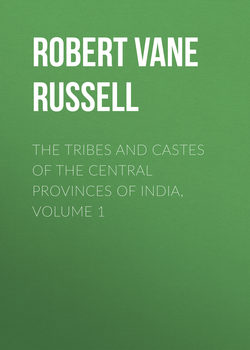Читать книгу The Tribes and Castes of the Central Provinces of India, Volume 1 - Robert Vane Russell - Страница 9
Part I.
Introductory Essay on Caste
Introductory Essay on Caste
6. Confusion of nomenclature
ОглавлениеNo adequate definition of caste can thus be obtained from community of occupation or intermarriage; nor would it be accurate to say that every one must know his own caste and that all the different names returned at the census may be taken as distinct. In the Central Provinces about 900 caste-names were returned at the census of 1901, and these were reduced in classification to about 250 proper castes.
In some cases synonyms are commonly used. The caste of pān or betel-vine growers and sellers is known indifferently as Barai, Pansāri or Tamboli. The great caste of Ahīrs or herdsmen has several synonyms—as Gaoli in the Northern Districts, Rawat or Gahra in Chhattīsgarh, Gaur among the Uriyas, and Golkar among Telugus. Lohārs are also called Khāti and Kammāri; Masons are called Larhia, Rāj and Beldār. The more distinctly occupational castes usually have different names in different parts of the country, as Dhobi, Wārthi, Baretha, Chakla and Parit for washermen; Basor, Burud, Kandra and Dhulia for bamboo-workers, and so on. Such names may show that the subdivisions to which they are applied have immigrated from different parts of India, but the distinction is generally not now maintained, and many persons will return one or other of them indifferently. No object is gained, therefore, by distinguishing them in classification, as they correspond to no differences of status or occupation, and at most denote groups which do not intermarry, and which may therefore more properly be considered as subcastes.
Titles or names of offices are also not infrequently given as caste names. Members of the lowest or impure castes employed in the office of Kotwār or village watchmen prefer to call themselves by this name, as they thus obtain a certain rise in status, or at least they think so. In some localities the Kotwārs or village watchmen have begun to marry among themselves and try to form a separate caste. Chamārs (tanners) or Mahars (weavers) employed as grooms will call themselves Sais and consider themselves superior to the rest of their caste. The Thethwār Rāwats or Ahīrs will not clean household cooking-vessels, and therefore look down on the rest of the caste and prefer to call themselves by this designation, as ‘Theth’ means ‘exact’ or ‘pure,’ and Thethwār is one who has not degenerated from the ancestral calling. Sālewārs are a subcaste of Koshtis (weavers), who work only in silk and hence consider themselves as superior to the other Koshtis and a separate caste. The Rāthor subcaste of Telis in Mandla have abandoned the hereditary occupation of oil-pressing and become landed proprietors. They now wish to drop their own caste and to be known only as Rāthor, the name of one of the leading Rājpūt clans, in the hope that in time it will be forgotten that they ever were Telis, and they will be admitted into the community of Rājpūts. It occurred to them that the census would be a good opportunity of advancing a step towards the desired end, and accordingly they telegraphed to the Commissioner of Jubbulpore before the enumeration, and petitioned the Chief Commissioner after it had been taken, to the effect that they might be recorded and classified only as Rāthor and not as Teli; this method of obtaining recognition of their claims being, as remarked by Sir Bampfylde Fuller, a great deal cheaper than being weighed against gold. On the other hand, a common occupation may sometimes amalgamate castes originally distinct into one. The sweeper’s calling is well-defined and under the generific term of Mehtar are included members of two or three distinct castes, as Dom, Bhangi and Chuhra; the word Mehtar means a prince or headman, and it is believed that its application to the sweeper by the other servants is ironical. It has now, however, been generally adopted as a caste name. Similarly, Darzi, a tailor, was held by Sir D. Ibbetson to be simply the name of a profession and not that of a caste; but it is certainly a true caste in the Central Provinces, though probably of comparatively late origin. A change of occupation may transfer a whole body of persons from one caste to another. A large section of the Banjāra caste of carriers, who have taken to cultivation, have become included in the Kunbi caste in Berār and are known as Wanjāri Kunbi. Another subcaste of the Kunbis called Mānwa is derived from the Māna tribe. Telis or oilmen, who have taken to vending liquor, now form a subcaste of the Kalār caste called Teli-Kalār; those who have become shopkeepers are called Teli-Bania and may in time become an inferior section of the Bania caste. Other similar subcastes are the Ahīr-Sunars or herdsmen-goldsmiths, the Kāyasth-Darzis or tailors, the Kori-Chamārs or weaver-tanners, the Gondi Lohārs and Barhais, being Gonds who have become carpenters and blacksmiths and been admitted to these castes; the Mahār Mhālis or barbers, and so on.
